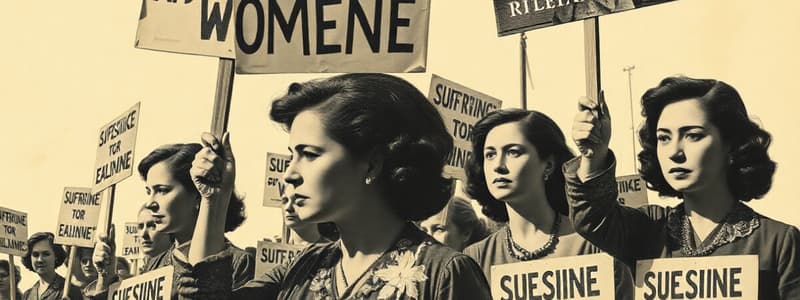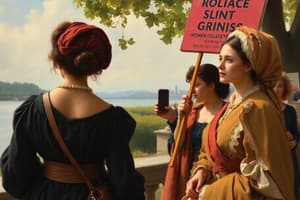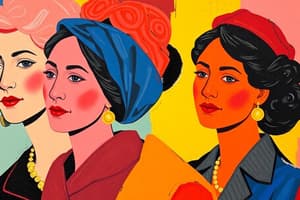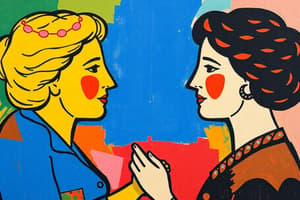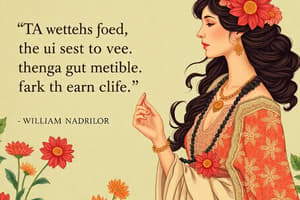Podcast
Questions and Answers
What does the caption "The Time Has Come To Conquer Or Submit.For Us There Is But One Choice.We Have Made It, President Wilson." suggest about the suffragists' stance?
What does the caption "The Time Has Come To Conquer Or Submit.For Us There Is But One Choice.We Have Made It, President Wilson." suggest about the suffragists' stance?
- The suffragists were prepared to use force to achieve their goals, but they were ultimately willing to submit to President Wilson's authority.
- The suffragists were confident that their efforts would ultimately lead to victory, and that President Wilson would eventually support their cause.
- The suffragists felt they had no other choice but to continue their activism, despite facing legal consequences. (correct)
- The suffragists were calling out President Wilson's hypocrisy in supporting democracy abroad while denying it to women in the United States.
The "Special Prison Pins" mentioned in the text were designed to:
The "Special Prison Pins" mentioned in the text were designed to:
- Recognize the sacrifices of the suffragists who were jailed for their activism. (correct)
- Motivate other suffragists to join the picket lines, even facing the risk of arrest.
- Serve as a symbol of unity and support for the suffragists during their imprisonment.
- Mark the specific crimes committed by each suffragist imprisoned.
The image and caption of Virginia Arnold's banner suggest a key strategy used by the suffragists was:
The image and caption of Virginia Arnold's banner suggest a key strategy used by the suffragists was:
- Highlighting inconsistencies in President Wilson's public pronouncements on democracy and his actions towards women. (correct)
- Appealing to President Wilson's sympathy for marginalized groups to gain his support.
- Using humor and satire to undermine President Wilson's authority.
- Using confrontational tactics to force President Wilson to address the issue of women's suffrage.
Based on the information provided, which of these statements is NOT supported by the text?
Based on the information provided, which of these statements is NOT supported by the text?
What is the primary difference between the two images provided?
What is the primary difference between the two images provided?
What did the suffragists' banners convey?
What did the suffragists' banners convey?
How did the suffragists use their skills as seamstresses in their activism?
How did the suffragists use their skills as seamstresses in their activism?
Why did the suffragists want to be treated as political prisoners rather than criminals?
Why did the suffragists want to be treated as political prisoners rather than criminals?
What message did the banner carried by Alice Paul convey?
What message did the banner carried by Alice Paul convey?
How did the suffragists use their protests at the White House to further their cause?
How did the suffragists use their protests at the White House to further their cause?
What did the suffragists' picketing in all kinds of weather demonstrate?
What did the suffragists' picketing in all kinds of weather demonstrate?
Which of the following best describes the rhetorical strategy employed by the suffragists in choosing the phrase 'To ask Freedom for Women is not a Crime'?
Which of the following best describes the rhetorical strategy employed by the suffragists in choosing the phrase 'To ask Freedom for Women is not a Crime'?
Why was the suffragists' demand to be treated as political prisoners a crucial aspect of their strategy?
Why was the suffragists' demand to be treated as political prisoners a crucial aspect of their strategy?
Flashcards
Activism and Slogans
Activism and Slogans
Slogans, hashtags, and banners were used by activists like suffragists to spread their messages and gain support.
Suffragist Banners
Suffragist Banners
Banners, sashes, and other visual displays were used by suffragists to communicate their message and attract attention during public events.
Prisoner Treatment Banner
Prisoner Treatment Banner
This banner highlights the suffragists' demand for equal treatment in prison. They argued that they were political prisoners, not criminals, and should be treated accordingly.
Suffragist Protests at the White House
Suffragist Protests at the White House
Signup and view all the flashcards
National Woman's Party
National Woman's Party
Signup and view all the flashcards
Conquer or Submit
Conquer or Submit
Signup and view all the flashcards
Alice Paul
Alice Paul
Signup and view all the flashcards
Perseverance During Protests
Perseverance During Protests
Signup and view all the flashcards
White House Picketing
White House Picketing
Signup and view all the flashcards
The National Woman's Party
The National Woman's Party
Signup and view all the flashcards
Imprisonment of Suffragists
Imprisonment of Suffragists
Signup and view all the flashcards
Special Prison Pins
Special Prison Pins
Signup and view all the flashcards
Kaiser Wilson
Kaiser Wilson
Signup and view all the flashcards
Study Notes
Suffragist Banners and Protests
- Activists used slogans and banners to spread messages, similar to modern hashtags like #MeToo, #NeverAgain, and #BlackLivesMatter
- Suffragists used their sewing skills to create banners and sashes for public demonstrations
- A banner held by Mary Winsor, a Pennsylvania suffragist, demanded that suffrage prisoners be treated as political prisoners, not criminals, for better treatment and to take their cause to court. She served two jail terms.
- Delegations of suffragists picketed the White House, sometimes in all kinds of weather, including cold January days. They wore rain gear
- Alice Paul led a picket line from the National Woman's Party headquarters to the White House. Her banner read: "The Time Has Come To Conquer Or Submit. For Us There Is But One Choice. We Have Made It, President Wilson."
- Dora Lewis, a suffragist in her seventies, followed Alice Paul in the picket line. President Wilson had recently declared that picketers would receive six-month prison sentences.
- Alice Paul commissioned artist Nina Allender to design pins to honor suffragists jailed for picketing the White House. Each of the 168 jailed suffragists received one of these silver pins.
- Virginia Arnold, a North Carolina suffragist, held a banner likening President Woodrow Wilson to a tyrant. The banner caused a near-riot.
Studying That Suits You
Use AI to generate personalized quizzes and flashcards to suit your learning preferences.
